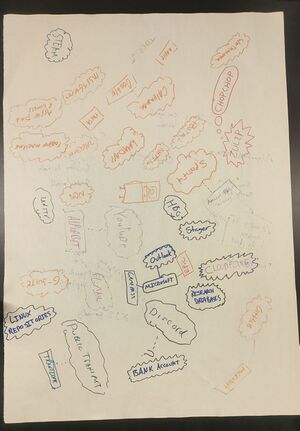User:Riviera/January 22 2024
On Monday 22nd January we discussed the Big Tech Cloud. Our discussion took place in several stages which I will unpack in this wiki post.
What issues are there with the cloud?
The discussion began with the sharing of two videos. The first of these videos, from the CNBC Explains series, sought to outline in lay terms what the cloud is. A salient point made in the video was that cloud computing offers consumers the ability to purchase devices with less built-in storage space. This is because, with a cloud storage subscription, user data (photos, videos, music) can be saved in the cloud. The video emphasised that the cloud is a collection of servers which are housed in data centers scattered around the globe. Whilst this video was accurate it did not critically engage with the problems associated with cloud computing.
Thus, we watched a second video from the Bots as Digital Infrapunctures curriculum. In this video, Seda Gürses takes computational infrastrctures as a point of departure for critical inquiry. ‘Computational infrastructures are’, according to Gürses, ‘more than a technological ecosystem and production system alone’ (Gürses 2021). Value systems are entrenched in these ways of computing. Furthermore, the cloud is reliant upon a mixture of ‘services’ which are plunged into obscurity (ibid.). Gürses points out that the Cloud has an environmental impact which must be taken into account. This theme is expanded upon by Anne Pasek (2023) . From Oregon to Ireland, Pasek emphasises the pressures which data centers place on resources (such as water and electricity) and communities. For Gürses, ‘cloudy landscapes [reflect] a techno-colonial regime that passes through deadly environmental damage and exploitative labour’ (Gürses and Rocha 2021, 1). During the discussion, Christina emphasised that The Cloud is not merely a bunch of data centers. It is this, plus a set of practices relating to infrastructure, software paradigms and economic models.
Having watched the videos we sat in the editorial groups which we formed during the Methods class last Wednesday. We agreed that these groups needed names but did not come up with any. The group I am in read through Habits, Data, Labour: From Warehouses to Data Centers (Magee and Rossiter 2022). The text discusses the links between ‘habits of data’ and ‘habits of labour’. What are the implications of these connections? In some respects, following on from last week’s methods class, they are spatial. Internal monitoring and data-collection facilitates a post-Taylorist approach to the layout of a working environment such as a warehouse. The text draws attention to the techniques of ‘data-driven management’ practised at Amazon. This is typified in ‘‘stack ranking’ – routine evaluations that score employees into categories, and eliminate those in the lowest quartile or decile’ (Kantor and Steitfeld in ibid.).
In light of such habits, we went on to discuss examples of strike action against the Cloud.
Bibliography
Gürses, Seda. 2021. “What Are Computational Infrastructures?” Utrect University.
Gürses, Seda, and Jara Rocha, eds. 2021. “A Catalogue of Formats for Digital Discomfort.” Institute for Technology in the Public Interest.
Magee, Liam, and Ned Rossiter. 2022. “Habits, Data, Labour: From Warehouses to Data Centers.” In Data Farms: Circuits, Labour, Territory, edited by Tsvetelina Hristova, Brett Neilson, and Ned Rossiter, 12–17. Open Humanites Press.
Pasek, Anne. 2023. “Getting Into Fights With Data Centers: Or, a Modest Proposal for Reframing the Climate Politics of ICT.” Experimental Methods and Media Lab, Trent University.

